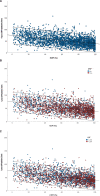The Association Between Kidney Donor Profile Index and 1-y Graft Function
- PMID: 37090122
- PMCID: PMC10118325
- DOI: 10.1097/TXD.0000000000001476
The Association Between Kidney Donor Profile Index and 1-y Graft Function
Abstract
The association between Kidney Donor Profile Index (KDPI) and 1-y estimated glomerular filtration rate (eGFR) with long-term kidney graft survival is well known. Yet, the association between KDPI and 1-y eGFR remains uncertain considering the several concurrent competing risk factors.
Methods: This single-center, retrospective cohort study analyzed data from 3059 consecutive deceased donor kidney transplant recipients with a 1-y follow-up from January 2013 to December 2017. The aim was to determine the association between the KDPI strata (0%-35%, 36%-50%, 51%-85%, 86%-100%) and 1-y eGFR estimated by the CKD-EPI equation.
Results: The incidence of delayed graft function (50.6% versus 59.3% versus 62.7% versus 62.0%; P < 0.001) and cytomegalovirus infection (36.7% versus 36.6% versus 43.3% versus 57.8%; P < 0.001) increased with increasing KDPI strata but not biopsy-proven acute rejection (9.1% versus 9.8% versus 8.4% versus 9.1%; P = 0.736). The median 1-y eGFR decreased with increasing KDPI strata (64.8 versus 53.5 versus 46.9 versus 39.1 mL/min/1.73 m2; P < 0.001). In the Cox regression, the higher the KDPI was, the lower the probability of a lower 1-y eGFR was. Assuming the 0%-35% strata as the reference, the likelihood of eGFR <50 mL/min/1.73 m2 was increased by 76.6% (hazard ratio [HR] = 1.767, 95% confidence interval [CI] = 1.406-2.220), 2.24- and 2.87-fold higher for KDPI higher >35%-50% (HR = 2.239, 95% CI = 1.862-2.691), and >51%-85% (HR = 2.871, 95% CI = 2.361-3.491), respectively. Other variables associated with a lower graft function were donor sex (HR male versus female = 0.896, 95% CI = 0.813-0.989) and cold ischemia time (HR for each hour = 1.011, 95% CI = 1.004-1.019). This association was sustained after the Poisson mediation analysis, including delayed graft function, cytomegalovirus, and acute rejection as mediators.
Conclusions: In this cohort of deceased donor kidney recipients, KDPI, and cold ischemia time were the major independent risk factors associated with lower 1-y kidney function.
Copyright © 2023 The Author(s). Transplantation Direct. Published by Wolters Kluwer Health, Inc.
Conflict of interest statement
The authors declare no conflicts of interest.
Figures





References
-
- Ojo AO, Hanson JA, Meier-Kriesche H, et al. . Survival in recipients of marginal cadaveric donor kidneys compared with other recipients and wait-listed transplant candidates. J Am Soc Nephrol. 2001;12:589–597. - PubMed
-
- Port FK, Bragg-Gresham JL, Metzger RA, et al. . Donor characteristics associated with reduced graft survival: an approach to expanding the pool of kidney donors. Transplantation. 2002;74:1281–1286. - PubMed
-
- Rao PS, Schaubel DE, Guidinger MK, et al. . A comprehensive risk quantification score for deceased donor kidneys: the kidney donor risk index. Transplantation. 2009;88:231–236. - PubMed
LinkOut - more resources
Full Text Sources
Research Materials
Miscellaneous

